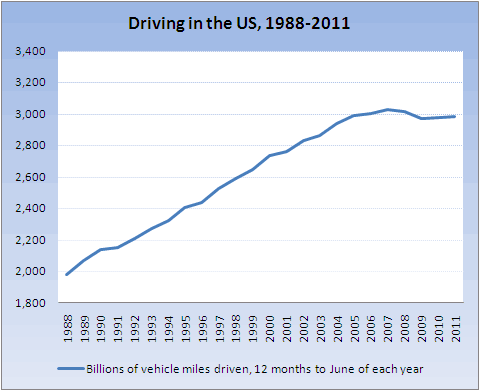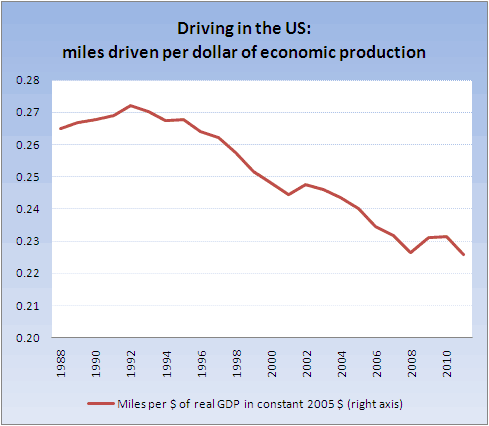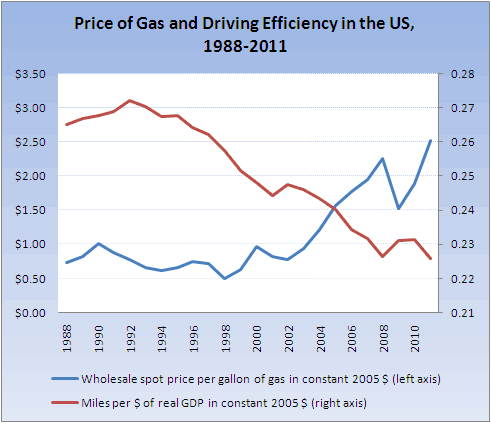While Americans will probably end up driving slightly more miles in 2011 than last year, they do appear to be getting more done per mile of driving. That’s the story told by the statistics recently released by the Federal Highway Administration describing the amount of driving done in the US. Plotting the total miles driven in each 12-month period ending in June (the most recent period being up through June 2011), we see that total vehicle miles has basically leveled off over the past few years, after approximately ten decades of continuous growth.
The End of an Era?
Is this the end to the heretofore endless rise in the amount of driving done in the US? Or is this just a temporary pause in the upward trajectory?

As much as I’d like to be able to conclude that we’ve already seen the all-time high for the amount of driving done in the US, that’s probably not the case. There are a few important big drivers (ahem) of the current pause in the growth in total vehicle miles. The first is the Great Recession. When fewer people are working, and when businesses are selling less output, some cars and trucks that would otherwise be on the road stay home. As economic activity picks up, those idle cars and trucks will increasingly be back on the road.
Second, there’s population growth. More people in the US means more driving, of course. And population growth in the US slowed in response to the recession (the US naturally attracts fewer immigrants during recession), though only by a bit — in 2010 the US resident population grew by about 0.85%, compared to an annual average of about 0.95% during the years 2001-2008. Once the economy strengthens, the US population will likely resume its ~1% annual average growth rate, once again putting a larger increment of new drivers on the road every year.
Improved Driving Efficiency
But then there’s the most interesting force affecting the amount of driving in the US: the secular trend toward doing less of it. A combination of factors has contributed toward a steady increase in what I call “driving efficiency”: the number of miles driven for each dollar of economic activity.

This has fallen quite steadily since the early 1990s. In 1992 approximately 0.27 miles were driven for each dollar of economic activity in the US, but so far this year that figure is down to about 0.225 — a 17% improvement. (Note that recessions clearly have an impact on driving efficiency as well, as can be seen in 1991, 2001, and 2009.)
There are a number of possible explanations for this 20-year trend in improved driving efficiency. Of course higher gas prices have played a role. The last chart plots the spot wholesale price of a gallon of gas (petrol) in constant 2005 dollars against driving efficiency in the US.
The chart confirms what we already know: gas has gotten more expensive in recent years (with the exception of the recession year of 2009), and that has surely been a catalyst for some improvements in driving efficiency recently. But it’s important to note that the secular trend toward increased driving efficiency was well underway before the high gas prices of the last several years, so clearly there are other forces at work as well.

Widespread changes in behavior unrelated to the price of gas must be a part of the story. People (and presumably businesses as well) have obviously been choosing to do more with less driving, whether out of environmental concerns or simply because they’re sick of sitting in traffic.
Driving Efficiency: Better, but Not Better Enough
But the secular trend towards improved driving efficiency that the US has enjoyed over the past 20 years is not going to be enough to keep the overall total miles driven in the US from rising again. To see why, we simply need to compare increases in driving efficiency with the forces that tend to cause more driving, such as population and economic growth.
Since 1992 driving efficiency in the US has improved by an average of about 1% per year. Efficiency improvements at that rate were more than enough to keep up with the growth of economic activity in the US recently, since GDP growth has averaged only 0.2% per year over the past 4 years. But once real GDP grows at more normal (faster) rates, driving effiency is going to have to improve by faster rates as well, or we’ll see the total miles driven in the US start to rise again. So for example, if real GDP grows at 3% in 2012 while driving efficiency only grows by 1.5%, the total miles driven in the US will reach record levels by the end of 2012.
More generally, in order for the total number of miles driven in the US to level off permanently, the US is going to have to experience improvements in driving efficiency that are at least as large (in % terms) as GDP growth. Note that the biggest gains in driving efficiency happened in 1999, 2006, and 2011, when Americans were able to cut the driving needed for each dollar of economic activity by about 2.3%. The US is going to need to improve its driving effiency by that much or more every year, on a sustained basis, before the total amount of driving done in the US peaks.
The World in the Hands of City Planners
Perhaps such sustained rates of improvement in driving efficiency in the US — more than double the rates we’ve seen over the past 20 years — are simply not possible, and the amount of miles driven in the US (and the amount of greenhouse gases emitted in the process) is destined to continue rising inexorably. But who’s to say we couldn’t do better? There’s no theoretical reason that driving efficiency couldn’t improve by 3 or 4 or 5% per year. But if such faster rates of driving efficiency are going to materialize, it seems likely that the only way to acheive them will be by making gradual but significant changes to the economic geography of the US.
Geography is not fixed, of course. Most of the geographic features that matter to us in our day-to-day lives were designed and built by humans: neighborhoods, roads, bridges, cities. And seemingly innocent and well-meaning ideas for how to structure our physical surroundings can have pernicious unintended consequences, particularly on the amount of driving that is done.
Take, for example, the parking lot. (Really, please take it. I don’t want it near me.) We’re all familiar with how a few large, badly-placed parking lots can destroy a neighborhood or a city center. But in a recent post about parking lots (yes, it is possible to write a post just about parking lots), a friend who’s a city planner points out that there’s a flip side to that: small changes in zoning requirements can potentially have big effects on the geography of cities, very possibly for the better.
The science of urban planning has evolved significantly over the past 20 years, and we have a much more sophisticated understanding of the unintended consequences (what economists generally refer to as externalities) of specific, local decisions made about our economic geography. If we want to permanently break the trend of ever-increasing driving in the US, that understanding, and how we apply it to our economic geography, is going to be crucial. So if it’s going to happen, it will be up to the city planners to show us the way.
- Bulenox: Get 45% to 91% OFF ... Use Discount Code: UNO
- Risk Our Money Not Yours | Get 50% to 90% OFF ... Use Discount Code: MMBVBKSM
Disclaimer: This page contains affiliate links. If you choose to make a purchase after clicking a link, we may receive a commission at no additional cost to you. Thank you for your support!


Leave a Reply